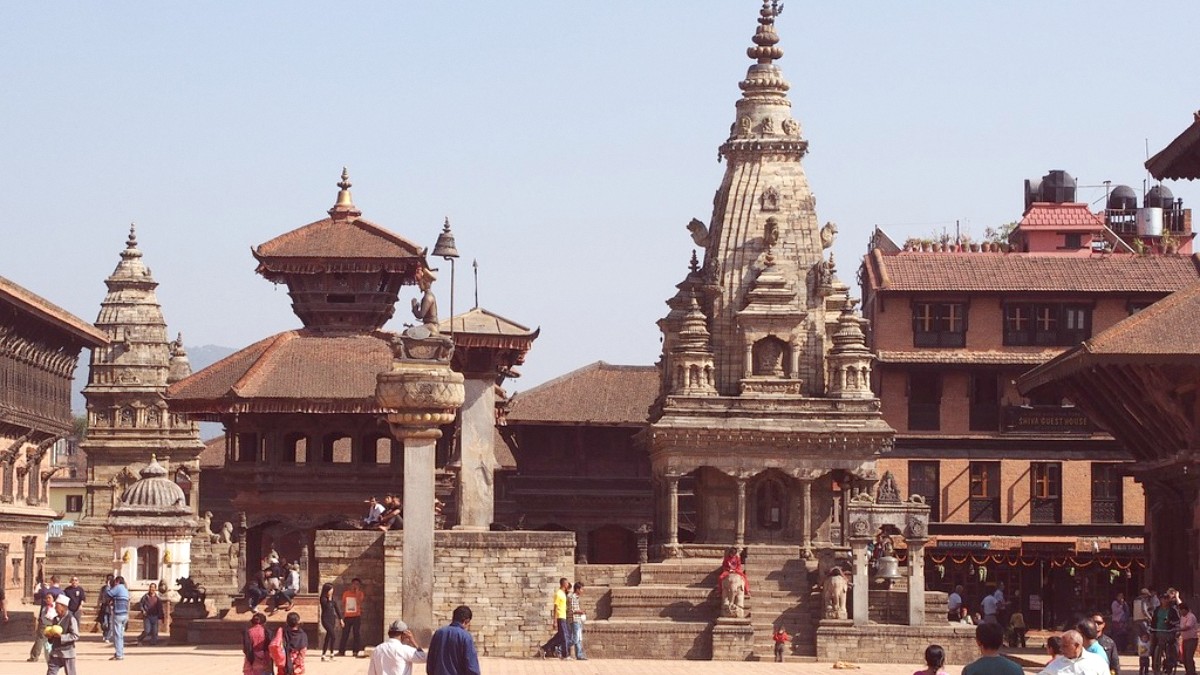
Around The Kathmandu Valley, Nepal
Bhaktapur, a stronghold of Newari culture, distinctively reflects this heritage in its cuisine. Newari food stands apart from general Nepali cuisine. It features savory and spicy dishes, a range of meats (buffalo, chicken, goat), and sometimes fermented ingredients.
Staples include rice, flattened rice (chiura), and lentils. Various meats, specifically buffalo, chicken, and goat, feature prominently. Fresh vegetables, mustard oil, and ghee (clarified butter) are also common. Newari cuisine uses a rich array of spices, including cumin, coriander, turmeric, chili, fenugreek, ginger, garlic, and Timur (a local Sichuan pepper). The flavors lean towards spicy, savory, and tangy, with distinct fermented notes in some dishes. Skilled use of local herbs and spices creates complex and satisfying tastes.
Eating with your right hand is common for traditional Nepali and Newari meals. The left hand generally stays unclean, so avoid using it to touch food or pass items.
While food often comes on individual plates, sharing dishes is common, especially with snacks or during communal meals.
Remove your shoes if eating in a traditional setting, like on cushions on the floor in a local eatery.
Bhaktapur's most famous specialty. A sweet, creamy buffalo milk yogurt, traditionally served in small clay pots. Richer and denser than typical yogurt.
Find it: Numerous shops around Dattatreya Square and Taumadhi Square sell Juju Dhau. Look for signs specifically advertising 'Juju Dhau.'
A traditional Newari platter. Includes flattened rice (chiura), barbecued buffalo meat (chhoila) seasoned with spices, dried ginger, black soybeans (bhatmas), and often a small portion of local alcohol (aila). A festive and hearty snack.
Find it: Find Samay Baji at Newari restaurants and traditional eateries throughout the old city.
Yomari: A traditional Newari dumpling from rice flour. Filled with chaku or khuwa and sesame seeds, then steamed. Shaped like a fig. Bara: Savory lentil patties, deep-fried.
Find it: Yomari seasonal (Dec), some eateries year-round. Bara at local Newari restaurants and small eateries.
A traditional Nepali ring-shaped bread, slightly sweet, deep-fried to a golden crisp. A festive food, often consumed during Dashain and Tihar.
Pustakari: Small, sweet, transparent candy-like squares from sugar and ghee, often flavored with nuts. Lakhamaari: Sweet fried bread, often made into intricate designs, traditionally prepared for special occasions.
Peacock Restaurant (Hotel Heritage): Within the beautifully restored Hotel Heritage, this restaurant has a refined dining experience. It serves a mix of Nepali and international cuisine in an elegant heritage setting.
Cafe Nyatapola: Situated near the iconic Nyatapola Temple, this cafe has stunning views of the square from its upper floors. It presents a mix of Nepali and international dishes.
Numerous small local eateries, known as "Bhojanalayas," serve affordable, authentic Dal Bhat and Newari snacks.
Compared to Kathmandu, international cuisine options remain limited in Bhaktapur. Some mid-range restaurants might provide basic Chinese, Indian, or Continental options.
Bhaktapur's dining scene truly stays in its authentic Newari and Nepali cuisine.
It is recommended to prioritize experiencing the local dishes for a genuine culinary adventure.
Many local specialties are unique to Bhaktapur.
Traditional Newari distilled alcohol from rice, millet, or wheat.
Traditional Newari rice beer, a fermented rice wine.
A sweet, spiced tea, a staple drink throughout Nepal.
Refreshing yogurt drink; seasonal fresh fruit juices are popular.
Halal food stays not widely available or certified in Bhaktapur. For Halal options, stick to vegetarian or vegan dishes, or seek out restaurants that specifically cater to Muslim communities, which are few.
Kosher food remains extremely difficult to find. Options likely stay limited to pre-packaged items or naturally kosher vegetarian/vegan dishes.
Consider preparing a written note in Nepali detailing your allergies. Awareness of cross-contamination remains limited. Nuts, soy, dairy, and various spices are common in Nepali and Newari cuisine.
Carry allergy cards translated into the local language.
Due to potential language barriers and varying awareness levels, clearly communicate all dietary needs.
While specific certifications might be rare, many local establishments are adaptable to simple requests like "no meat" or "no dairy" when explained clearly.
Some local guesthouses or tour operators in Bhaktapur may host Newari cooking classes. These often focus on preparing staple dishes like Dal Bhat or specific Newari specialties.
Food tours combine visiting bustling local markets with tasting a variety of street food and traditional meals, an excellent overview of the local culinary scene.
Formal farm visits remain limited directly within Bhaktapur city. Observe local farming in surrounding villages just outside the city.
Many restaurants and cafes around Durbar Square and Taumadhi Square present rooftop seating. This has stunning views of the temples and squares, especially at sunset, enhancing your dining experience.
Grab a drink and view the perspective.
Places like the Peacock Restaurant at Hotel Heritage allow you to enjoy meals surrounded by exquisite historical architecture.
A truly immersive historical experience.
Familiarize yourself with the unique flavors of Newari cuisine.
Do not hesitate to ask locals for their favorite eateries.
Explore the smaller alleyways for hidden culinary treats. Try Juju Dhau from multiple vendors to find your favorite.
Tipping in Nepal is not mandatory but certainly appreciated. For restaurants, a 10% service charge may already appear on your bill; if not, leaving 5-10% of the total bill is a good gesture.